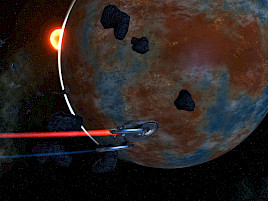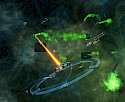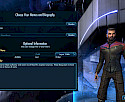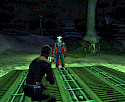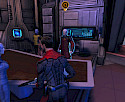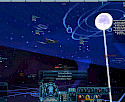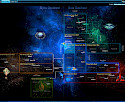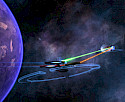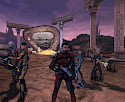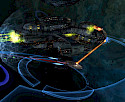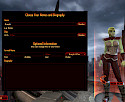Star Trek Online Preview
Star Trek Online is an MMO that certainly lives up to the “massively” part of that abbreviation and, whilst we’d love to spill all the beans in the preview, we’re restricted not only by a review embargo until the 2nd of February but also by the fact that the game is so incredibly vast. To put that into perspective, in two weeks we’d barely scratched the surface in terms of the missions that progress the overall storyline of the game and we’d only increased in rank from Ensign to Lieutenant Commander (the game allows you to progress up to Rear Admiral).
Please bear in mind that, unlike some other previews you may have read, we did actually wait until the end of Beta to do our write-up after various patches and improvements had been applied to the game, so we’re basically giving you our impressions of the final version of the game that anyone will see until the game is released to the paying public. Trust me – that’s a heck of a difference as interfaces were overhauled, graphics were tuned, missions were tweaked and Leonard Nimoy was added.
So, here to give you a brief overview are both myself – Pete, aka “Captain” Jayne Cobb of the USS Jaynestown – and Neil, aka “Captain” Jack O’Neill of the USS Valkyrie. Not sci-fi nerds in the slightest. Honest. I’m a novice to MMOs preferring strategy and FPS titles but a huge Trek fan, and Neil is an MMO veteran and, it’s fair to say, general sci-fi/fantasy all-rounder having put in countless hours playing games such as Eve Online, Lord of the Rings Online and many others.
With that lot out of the way, let’s begin.
As a little bit of a backstory, the game takes place a few decades after the destruction of Romulus but in the primary timeline – not the alternate timeline created during the course of events in JJ Abrams’ Star Trek reboot. So Spock is gone, the Romulan homeworld is no more and in the intervening years this has led to a massive shift in power throughout the Alpha and Beta quadrants. The Klingons have broken off all ties with the Federation, conquered several races and become incredibly paranoid, Sela (Tasha Yar’s daughter following the events of Next Generation episode Yesterday’s Enterprise) is now Emperor of a new Romulan Star Empire which is another cause for concern to the Federation and, as if all that wasn’t bad enough, the Borg are knocking on the back door. Well it’s more like they’ve broken in and are running muddy footprints up and down the hallway to be honest – they are such scamps!
First up in the game following the neat Federation introduction movie (as voiced by Leonard Nimoy – nice touch!) is character creation. You choose your career path from a choice of Tactical, Engineering and Science with each offering you their own unique advantages in both space and ground arenas. Tactical Officers are the brawn of the outfit, Engineering fix your ship up nicely after you engage in countless battles and Science Officers tend to be healing you rather more often than you’d care to admit to.
The character creator lets you choose gender, species, facial features, dimensions (and yes, those dimensions too if you’re into creating a crew of Lara Crofts), skin colour/tone and so on. You can pick from a modest-yet-varied list of Federation races to begin with or try your luck with something more alien until you’re finally happy with a character with which you’ll spend a lot of time following in third person.
As the uniform regulations have been relaxed by this point in the future, you can also choose from a variety of snazzy outfits that, frankly, I’ll bet the cast of Star Trek wished were available to them during the various series’. In general the outfits seem to mostly consist of leather, and this time out you can choose your colours too so you can be as garish as you like or just stick with a Next Generation outfit if you like. We would point out though that, sadly, as soon as you put armour on yourself and your crew your uniform choice is rendered somewhat moot as you won’t see it again until the armour comes off – and why would you ever want to do that in such a hostile universe?
It’s also worth noting that you can customise the appearance of your other bridge officers and also your ship to an extent later on in the game until you have your dream team of officers.
So now I’d like to introduce you to “Captain” Jayne Cobb. His back-story is that he didn’t much like the look of the last captain and threw him out the nearest airlock.
All joking firmly aside and moving swiftly on, the game begins with your character at a rank of Ensign by placing you into the lounge on the USS Khitomer – there’s not a synthehol in sight though as the Khitomer is in a pitched battle against the Borg at present and you’re to report for duty immediately.
This part of the game is the tutorial phase though, so there’s little worry of the Borg posing much of a threat. The general gist is that they’re behaving oddly and whisking away all the higher ranking officers mysteriously, which is a nice plot point that enables you to be in command of a starship whilst at such very low rank.
It introduces you (aided by the voice of Zachary Quinto as the ship’s Emergency Medical Hologram) to the ground-based element of the game, where you’ll generally find yourself shooting enemies, interacting with civilians (nothing seedy, shame) and scanning all manner of weird and wonderful things. Then it moves on to the space combat by pitting you against some fairly weak Borg probes whilst you work out how to move your ship in three dimensions, what your keys do and ends with you usually binding the all-powerful Fire All Weapons command to a single key so that you don’t just end up mashing your keyboard by firing weapons one at a time. Maybe that’s just me though.
The tutorial can be tedious and it does seem almost too long if you know your way around the sort of complex interfaces found in other MMOs and strategy games, however it does serve another purpose in that it also begins to immerse you into the storyline and atmosphere of the journey you’re about to embark on.
Once through the tutorial, things calm down for a little while as you return to the Sol system and the main starbase back at Earth where Admiral Quinn gives you a slap on the back, some new missions to embark on and the keys to a new starship (well there is a war on you know and the highest ranking officer on a ship is technically the captain, even if they are only a Lieutenant).
It also give you your first taste of the skills system, whereby you get various points for embarking on certain missions which boost your character’s overall experience. There are ten levels at each rank (so level 3 Lieutenant for example) and when you have enough mission-based experience you go up a rank, get a promotion, a better ship and more character/class-specific skills to choose from. Your crew can also be promoted from Ensigns to Lieutenants when you reach Lieutenant Commander level, depending on their own experience. With each rank you gain, you can train your crew up to the rank below, and this unlocks new special skills for them and yourself.
This is where the game leaves the linearity of the earlier tutorial and lets you choose your missions from several high ranking officials. Each offers you different types of mission from fleet actions, deep space exploration missions, escort missions and so on which I’ll expand on a little later.
Your method of actually getting from place to place in the game is handled by way of an Astrometrics view where you’re not viewing your ship in real space, but rather as a playing piece on a vast game board. There are many systems in each sector and many more sectors in each of the playable quadrants in the game – currently Alpha and Beta. In this view you can plot a course to any system or object in your sector of space or even view your position on the galaxy map, which generally has the effect of showing you how tiny and insignificant you are in the grand scheme of things whilst also giving you a better perspective from which to find some of the more remote places you might be asked to go to.
Once at a location, you’ll generally enter the solar system and receive a set of instructions – usually defeat the enemy and approach the planet or just approach the planet and beam down, though there are occasionally more peaceful invitations. If it’s a space battle you’re faced with, you’ll usually be up against a few small groups of ships where your weapons training will come to the fore as you broadside the enemy and drain a particular section of shields before hitting them hard with a final barrage of torpedoes and sustained phaser fire. Your crew also give you a bit of a boost here as different crew members can be specialised in specific areas, so you can fire off a particularly high-yield salvo of torpedoes or fool the enemy’s sensors for a short period.
You often find rings or asteroids surrounding planets, the latter of which are quite useful to hide behind in combat. As you approach, you get a sense of just how big each planet is compared to your ship. They might look small when you arrive in the system but they’re quite and detailed and vast close up – something that you wouldn’t have been able to do several years ago.
Once planet-side the game consists of either exploration (running around scanning things with your tricorder) or, more often, getting into fights with Klingons, Gorn, Orions (or worse) before rescuing scientists or collecting data. There is some variety in the types of missions, but not a great deal at present. You will come across a wide variety of scenery once planetside though, as we were happily unable to encounter the same environment, foliage or landscape twice across all the missions we played.
If you’re into MMOs and other strategy games where you choose skill paths based on experience, the levelling up of your skills is something you’ll enjoy, so the repetition does have its rewards.
What really saves the game for me is the evolving story. If you skip all the on-screen dialogue then you’ll miss out, as with each story-based mission (usually provided by Admiral Quinn in the early game) you get more of an insight into why the Klingons are so on edge, the lengths they’ll go to to get what they want (think major Star Trek plot devices here – time travel being one of them) and so on. It’s also greatly helped by familiar characters including Commander Naomi Wildman (who you’ll remember as a little girl in Star Trek Voyager), Captain Mackenzie Calhoun of the Star Trek New Frontier book series, Lieutenant Miral Paris - who has her own interesting story arc - and there will doubtless be more friendly faces to follow in later missions and other sectors of space.
This preview has focused quite a bit on the Federation and Klingons and they are the only two playable factions in the game thus far (Klingons are unlocked as playable at Lieutenant level 4), but there are other missions in other sectors of space where you’ll be dealing with Romulans, Cardassians, Borg and other races.
We’re also expecting that the Klingon campaigns, currently in their early stages, will be fleshed out over the coming months and new playable factions to appear in future updates (we’re betting on Romulans next) but for now there’s more than enough to chew on for the average, casual player – less so for the hard-core players who’ve taken a week off work to get to Admiral as quick as possible but frankly that’s their problem.
With some good storylines beginning, time travel in the mix already along with rumblings from the Dominion and the potential appearance of Section 31, we’re looking forward to future updates and we’ll dig deeper into all this for you in a future review or two. For now though, this should give you a small taste of what to expect when the game hits the shelves.


